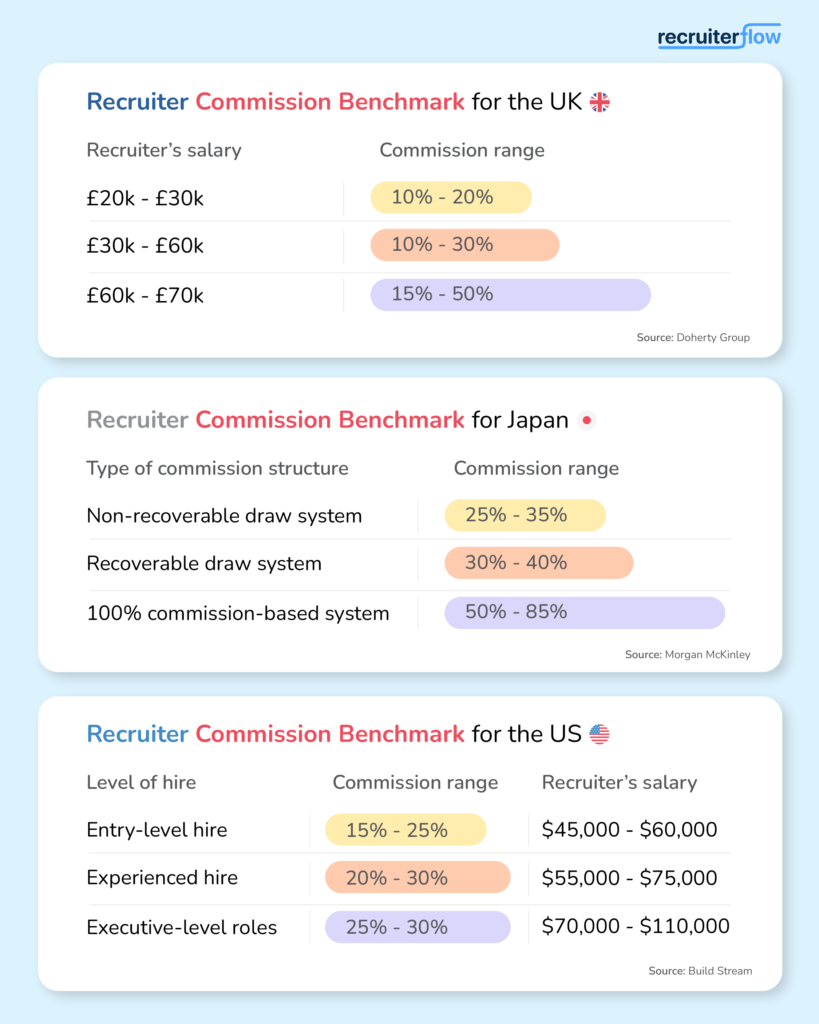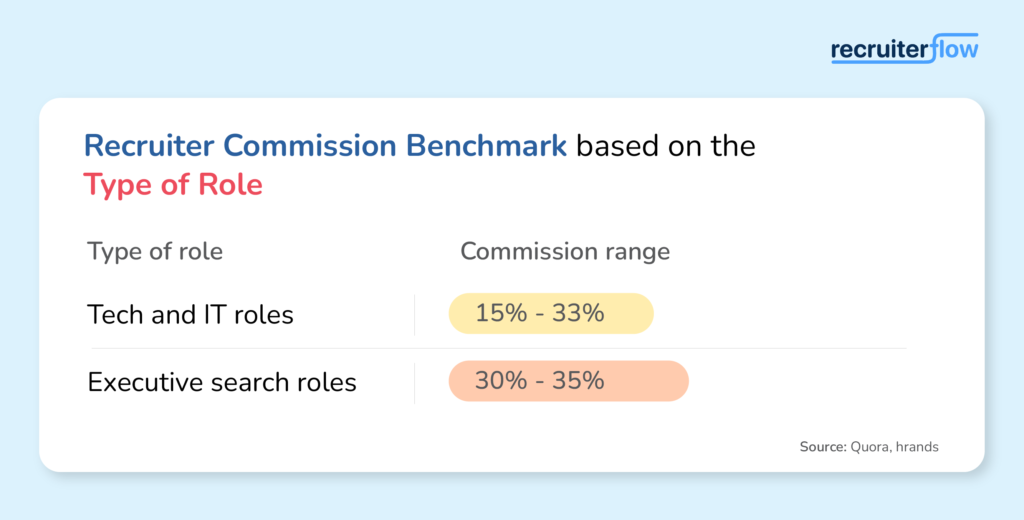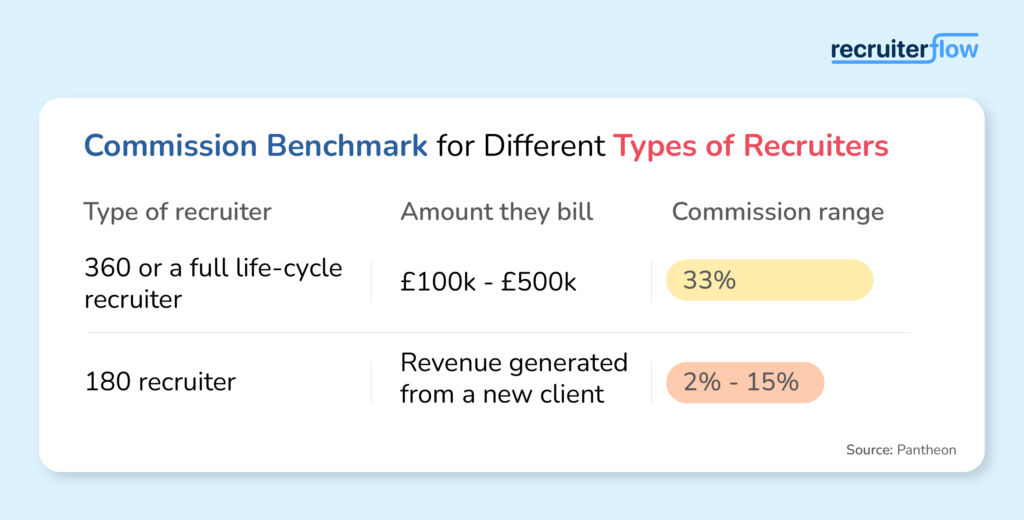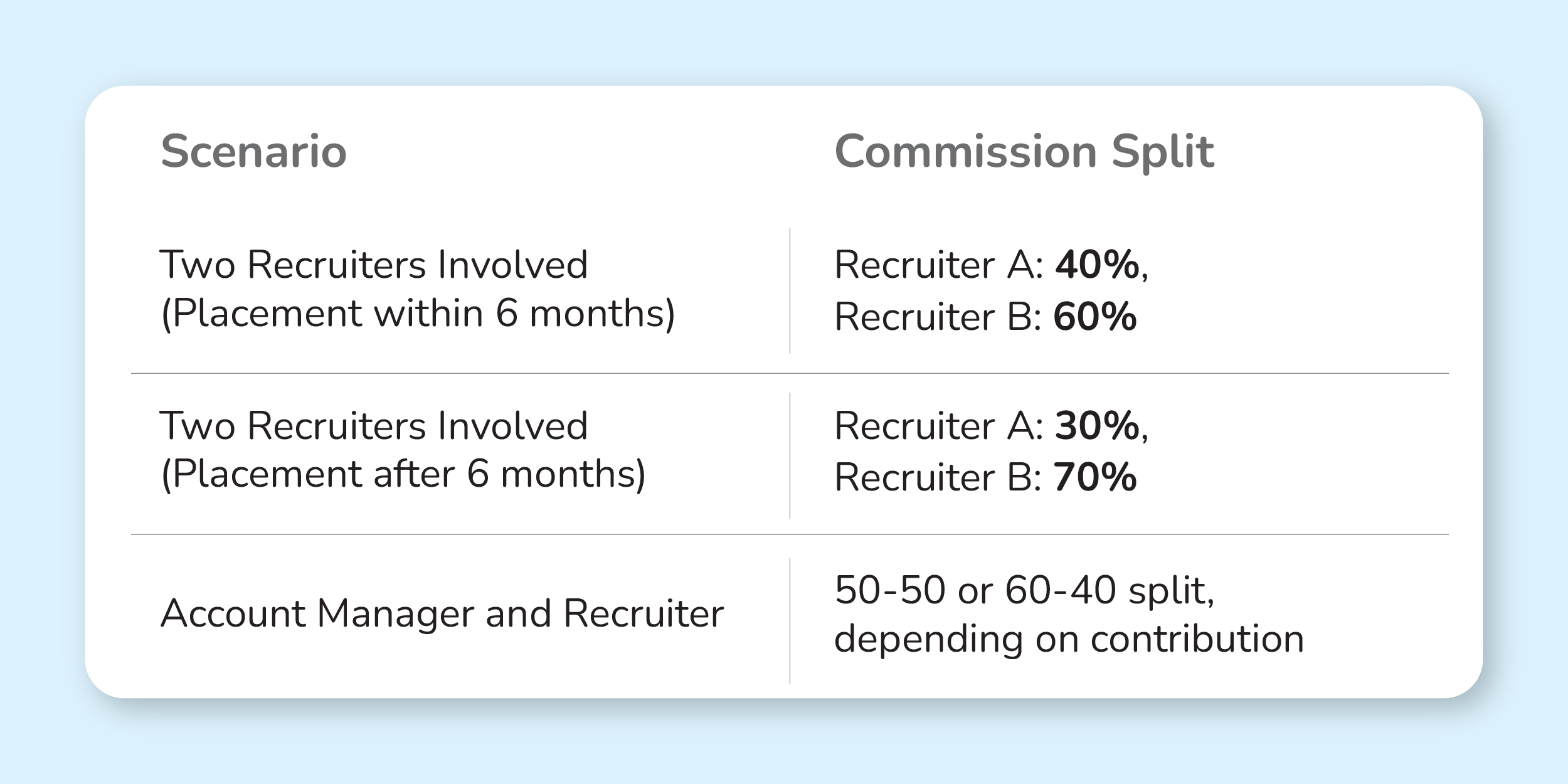
A Complete Guide to Recruiter Commission Structure

Creating a fair recruiter commission structure is crucial for a recruiting business. That’s because your compensation strategy directly impacts your bottom line and your team’s motivation.
The planning requires some intense reflection, data-crunching, and digging into deep insights. Given how much your recruiters work to close deals and bring in business, you need to make sure they’re being leveled out with the needs of the rest of your agency.
Today, we’ll be looking at what makes a good recruiter commission structure and sharing some examples from within the recruiting industry.
What is a recruiter commission structure?
A recruiter commission structure is a plan that outlines how an agency compensates their team of recruiters.
The best way to look at it is the sales rep compensation model. Like sales agents, Recruiters get paid for their performance in the form of commissions weaved around deals closed—with success measured based on parameters such as placements made and/or seniority level.
To help you get started, we’ve put together a free Google Sheets template you can use to easily calculate recruiter commissions based on your own setup, just click the image below to download it.

Why is the recruiter commission structure important?
Implementing a commission-based structure for your team of recruiters can be beneficial for your agency in many ways:
- It makes recruiters accountable for the number and the quality of placements they make in a month or quarter. This pushes them to hit bigger targets as their earnings depend on their efforts.
- Choosing a structure that works both for the team and the agency helps small agencies plan their resources better.
- Commission-based structures create a result-driven environment.
Despite the benefits, a commission-based compensation structure can result in recruiters prioritizing quick placements over long-term fit. Plus, it’s important to analyze if this approach actually aligns with your needs and values.
Types of commission structures for recruiters
The right structure for compensating your recruiters can vary—there’s no one-size-fits-all approach. However, there are some typical structures that are almost always used in the recruitment industry.
1. Commission with a base salary
A base salary plus commission is the most classic form of a recruiting commission structure. In this structure, agencies pay their recruiters a base salary plus commission on every successful placement.
The standard base salary to commission ratio is 60:40, where 60% is a recruiter’s base salary and 40% is the commission they earn.
| Pros | Cons |
| More financial stability for the team as they get a fixed monthly income | Recruiters may settle for the base salary they get and overlook the benefits of pushing beyond their limits to earn a commission. |
| It promotes a positive work culture where the team is motivated to perform without the pressure to earn | If recruiters have not been performing or it’s slow at your end, base salaries can affect the profitability of your agency. |
| A fixed salary can create a more collaborative and less competitive environment, fostering teamwork and knowledge-sharing | Top-performing recruiters might lack motivation where earnings are capped, unlike a pure commission model with no ceiling. |
2. Tiered commission
Under this commission plan, agencies offer varying commission rates based on performance levels. This structure can be used in conjunction with base salary or on its own for commission-only reps.
Ideally, the commission is based on factors such as:
- Candidate compensation structure: This is when you assign a set percentage of commission for recruiting candidates based on the salary range of the candidates.
For example:- 5% commission rate for salaries up to $50,000,
- 7% commission rate for salaries between $50,000 and $100,000, and
- 10% commission rate for salaries above $100,000.
- Number of placements: This is more based on the number of candidates recruiters hire during a defined period.
For example:- 5% commission for the first five deals
- 6% for the next five
- 7% for deals for the next two
- 8% for any additional deals
Who should use tiered commission structures?
- Executive search firms: Tiered commission motivates recruiters to give continuous high performance.
- Tech recruiting agencies: These roles often come with high placement fees, and the tiered structure can motivate recruiters to fill them efficiently and consistently.
- Large recruitment agencies: Agencies with a broad client base and varied role types can use compensation-based tiered commissions to encourage recruiters to move beyond filling the low-hanging roles and focus on high-value placements
| Pros | Cons |
| Clear incentives motivate recruiters to surpass their targets and earn higher commissions | The process can become too competitive, which can lead to unhealthy competition among recruiters. |
| The possibility of earning more by hitting higher tiers ensures that recruiters do not become complacent after a few successful placements. | It may cause a disparity in earnings between top performers and those who struggle to reach higher tiers. |
| It helps retain top-performing recruiters. | The pressure to continuously achieve higher tiers can lead to recruiter burnout. |
3. 100% commission
In this kind of arrangement, there’s no fixed pay, and recruiters get paid only after making successful placements. So, when a recruiter successfully places a candidate, the agency will charge a placement fee to the client while the recruiter receives a specified percentage of that.
| Pros | Cons |
| It can be cost-effective for startups. | It’s difficult to retain your recruiters for long—especially those who prefer some kind of stability with their incomes. |
| Those who are skilled in recruiting can make a lot more money than they would with a fixed pay package. | Recruiters might adopt a tendency to focus on the quantity of placements rather than the quality. |
| This structure is aimed at making recruiters think and act like entrepreneurs, who must be proactive, resourceful, and self-motivated. | When recruiters work under 100% commission structures they tend to be less likely to share leads or collaborate. It results in highly competitive environments that are hard for them to thrive in. |
4. Threshold commission
A threshold is the amount of revenue a recruiter needs to bill before they can start earning a commission. For example, a recruiter billed $60,000 i.e. recruited a candidate with this much annual salary, and the threshold is $45,000, here’s how the commission will be calculated:
Commissionable Revenue= $60,000 – $45,000 = $15,000
Commission earned = 10% of $15,000 = $1500
How is threshold-based commission calculated?
Approach 1: Multiplying the base salary
Monthly Base Salary: $5,000
Multiplier: 9 (A standard number)
Revenue = 5000 x 9 = $45,000
This means a recruiter needs to bill $45,000 in revenue in a given timeframe before they start earning commissions.
Approach 2: Flat figure
This is usually a fixed figure a recruiter needs to bill before earning commissions, regardless of their base salary.
| Pros | Cons |
| This is a great way of avoiding mediocre performance. | Recruiters have to wait until they can actually earn some commission. |
| This structure aligns recruiters’ efforts with the company’s financial goals, as they need to reach a certain level of revenue before earning additional compensation. | Higher base salaries mean higher thresholds, which often set unrealistic/difficult targets for recruiters. |
| Recruiters with lower base salaries may find it harder to surpass the fixed threshold compared to a proportional multiplier method |
5. Draw commission
In this system, you pay your recruiters an advance payment against their future commissions. It can be of 2 types:
- Recoverable Draw: If the recruiter’s earned commissions exceed the draw amount, the recruiter is paid the difference. If commissions are less than the draw, the shortfall is carried over to future periods.
- Non-Recoverable Draw: The draw is treated as a guaranteed minimum payment and does not need to be paid back if commissions do not exceed the draw amount. The recruiter gets to keep the draw regardless of their commission earnings.
Example of draw commission
Monthly Draw = $3,000
Commission Rate = 10%
Monthly Revenue Generated = $40,000
Commission earned= 10% of $40,000 = $4,000
Payable Commission = $4000 – $3000 = $1000
| Pros | Cons |
| The fixed draw offers a safety net, while the commission component acts as a motivation to push limits. | A recoverable draw may inflict debt on underperforming recruiters over multiple pay cycles. |
| A draw serves as a benchmark for recruiters to target every month. | Draw commissions are often set lower than base salaries. So they only guarantee minimum payouts. |
How much do recruiters make in commission
Commission benchmark for the UK (source: Doherty Group)
| Recruiter’s salary | Commission range |
| £20k – £30k | 10% – 20% |
| £30k – £60k | 10% – 30% |
| £60k – £70k | 15% – 50% |
Commission benchmark for Japan (source: Morgan McKinley)
| Type of commission structure | Commission range |
| Non-recoverable draw system | 25% – 35% |
| Recoverable draw system | 30% – 40% |
| 100% commission-based system | 50% – 85% |
Salary and commission benchmark for the US (source: Build Stream)
| Level of hire | Commission range | Recruiter’s salary |
| Entry-level hire | 15% – 25% | $45,000 to $60,000 |
| Experienced hire | 20% – 30% | $55,000 to $75,000 |
| Executive-level roles | 25% – 30% | $70,000 to $110,000 |

Commission benchmark based on the type of role (source: Quora, hrands)
| Type of role | Criteria | Commission range |
| Tech and IT roles | Based on the number of roles or the amount recruiters bill | 15% – 33% |
| Executive search roles | A percentage of what the agency charges for a candidate’s annual or half-yearly salary | 30% – 35% |

Commission benchmark for different types of recruiters (source: Pantheon)
| Type of recruiter | Amount they bill | Commission range |
| 360 or a full life-cycle recruiter | £100k – £500k | 33% |
| 180 recruiter (Business Development Managers, Account Managers, Resources, and Delivery Consultants) | Revenue generated from a new client | 2% – 15% |

How to set up a commission structure for your agency
1. Assess your current recruitment ecosystem
The first step is to analyze your current recruitment process and team dynamics to identify bottlenecks in your compensation models and productivity levels.
Ask yourself these questions:
- How much are your top recruiters earning compared to your lowest producers? Does the compensation seem fair across different levels of performance?
- What’s your turnover rate? Are your top recruiters leaving for higher-paying roles?
- Are your team members who hit their placement quotas as productive at the end of the month as they are at the beginning?
- Does your current commission structure allow your agency to remain profitable while still rewarding your recruiters adequately?
Remember, it’s important to choose a compensation structure that motivates your team, drives performance, and helps you smash your agency’s goals.
2. Decide the level at which the commission kicks in
But first, settle on a fair base salary—something that’s modest (not too much and not too little!). Always, make sure there’s enough room for growth that your recruiters can achieve by hitting more targets and billing more every month or quarter.
Once you have that settled, determine when you should introduce the concept of commissions.
Do you want your entry-level recruiters to first learn the ropes and get into the grind before they can go for the bigger challenge? Or do you want to ensure they surpass a minimum revenue or your cost per seat before their commission kicks in?
Not to forget, you can choose between other low-risk commission structures that are either 100% commission-based with no base salaries or tiered structures that reward recruiters solely on the basis of their performance.
Another point to consider here is to ensure the cost incurred by your agency in hiring a recruiter is covered before you start paying a hefty sum of commissions to them.
3. Understand your cost of seat
Cost of seat refers to the total cost your agency will have to incur to accommodate each recruiter. This doesn’t just include the salary, but the costs associated with providing them with the necessary resources and support.
How to calculate cost of seat
Start by calculating the total operational costs, which include:
- Salaries and benefits for all employees, including managers and administrative staff
- Office rent, utilities, and maintenance
- Technology and software expenses
- Training and development programs
- Marketing and advertising costs
- Miscellaneous operational expenses
Subtract the total salaries of your recruiters from the total costs and divide the remaining amount by the number of recruiters in your agency.
Example: Total Operational Costs: $1,000,000
Salaries of recruiters: $500,000
Number of recruiters: 10
Cost per seat = ($1,000,000 – $500,000) /10 = $50,000
Once you have the cost per seat, add the base salary of the recruiter to this amount. This will give you the minimum revenue a recruiter must generate to start contributing to your agency’s profitability. It’s generally a good idea to base your threshold commission structure around this amount
4. Setup frequency of payment and the timeline
The next step to pay attention to is determining how often to roll out commissions to your recruiters. Not only does it help you manage your business cashflows effectively, but also prepares you for unexpected financial strain.
The most common among recruitment agencies is monthly payout (over 80% of TRN members pay monthly to their recruiters). However, when determining the right payment cycle for your agency, you must consider your average deal cycle.
Quarterly commission payout
If a deal takes months to close, a quarterly commission payout might work best for you. For example, if it takes longer to receive payments from a client, it’s wise to wait until you get that payment to start distributing commissions.
Benefit
Quarterly commissions provide a more comprehensive view of a recruiter’s performance and contribution over time.
Monthly commission payout
If your recruitment deals typically close within a few weeks, a monthly commission payment schedule is appropriate. Needless to say, recruiters love being rewarded promptly for their services.
Benefit
Timely rewards that match the effort and duration of the recruitment process help maintain recruiter motivation and retention.
Best practices for determining the commission payout frequency
- Survey your team and understand their preferences.
- Consider what is standard in your specific recruitment market. For example, high-stakes executive search firms might lean towards quarterly payments due to the longer deal cycles, while temp staffing agencies might prefer monthly payments due to the quick turnover of placements.
- Carefully analyze your deals cycle. Collect historical data from past placements—the date the role was opened, the date the candidate was placed, and the date the client was billed.
You can also explore our detailed guide on the Staffing Agency Contract Template to simplify your contract management and get free downloadable templates!
How does split commission between multiple recruiters work
If you have 360 recruiters handling an account all by themselves, the commission structure becomes pretty straightforward—you pay them a percentage of what you earned from a client. However, when multiple stakeholders come into the picture, the approach changes.
Besides the recruiter, there could be an account manager or another recruiter involved, taking care of a part of the process for one candidate. In this case, you’ll need to split the commission between the parties based on their level of contribution.
Here, you need to take 3 factors into account:
- Who gained the business?
- Who found the candidate?
- Who recruited the candidate?
Case 1: When 2 recruiters are involved
This is when Recruiter A sources the candidate and Recruiter B recruits the candidate. Should the commission be divided 50-50 among the two?
No. In this case, recruiting is more time-consuming and requires more effort, so it’ll be given more weightage than sourcing. But how much?
2 situations apply here:
- If Recruiter B places the candidate within 6 months of sourcing
Recruiter B gets a 60% share of the commission and Recruiter A gets 40%
- If Recruiter B places the candidate after 6 months of sourcing
Recruiter B will get a much larger share of the recruitment commission than Recruiter A—ideally, a 70-30 split will be there.

Case 2: When an account manager is involved
Usually, in 360 recruitment, the recruiter handles the entire recruitment process from start to finish. This involves:
- Identifying and securing new business opportunities
- Writing and posting job descriptions to attract suitable candidates
- Identifying potential candidates through various channels
- Arranging and conducting interviews with candidates
- Coordinating interviews between clients and candidates
- Managing offer negotiations, including salary and benefits discussions
But when an account manager comes into the picture, the commission is split between the two. Here are the different scenarios:
- 50-50 split where both the recruiter and the account manager contribute equally.
- 60-40 split between account manager and recruiter (higher effort in acquiring new clients) and vice-vera
Case 3: Based on the level of seniority of recruiters
Here’s how the commission is generally split:
| Role | Commission split |
| Junior Consultant | 1/3 split |
| Consultant | 2/3 split (if the candidate is from a junior) |
| Senior Consultant | Between 12.5% – 25 % (post surpassing threshold) |
| Lead Consultant | Between 17.5% – 30% (post surpassing threshold) |
Recruitment commission structure examples
Different agencies use different recruiter commission structure plans, based on what’s right for them and their recruiters. We’ve picked some of the best commission schemes listed by The Recruitment Network (TRN).
Example 1: Commission based on cumulative Net Fee Income (NFI)
NFI is the placement fee a recruitment agency makes from placing permanent and temporary candidates, and advertising job openings. For larger agencies, it also covers earnings from additional services like recruitment process outsourcing, consulting, and managing payrolls for other businesses.
Here’s how an agency can categorize recruiter commission percentages based on cumulative NFI:
| NFI | Commission |
| £0 – £100,000 | 5% |
| £100,000 – £150,000 | 10% |
| £150,000 – £200,000 | 20% |
| £200,000 – £250,000 | 40% |
How does this scheme work?
- It has no minimum threshold for recruiters to start earning commissions.
- The commission is paid every month.
- Higher billing = higher commission.
- The commission structure is divided into different bands based on the cumulative NFI (Net Fee Income) a consultant generates throughout the year. At the start of each year, the cumulative NFI is reset to zero, and the consultant starts fresh in the lowest band.
- Consultants take home at least 33% of what they bill in total remuneration (base salary plus bonuses/commissions).
Example 2: Commission based on gross margin
Gross margin is the difference between what the client is charged for the recruiter’s work and the cost to the business of paying the recruiter. In this commission scheme, you pay a percentage of the Gross Margin attributable to you.
| Gross margin per month | Commission |
| £0-£18,000 | 11% |
| £18,001+ | 12.5% |
How does this scheme work?
- The commission is paid every month.
- It has no minimum threshold for recruiters to start earning commissions.
- Higher billing = higher commission.
- Incentivizes recruiters to increase their gross pay by billing higher.
Example 3: Commission based on total billings
Unlike the above two examples, this commission scheme is based on the total revenue generated from placements. It doesn’t include associated costs or profit margins. Since this scheme is highly dependent on the threshold and total billing is done every month, it varies for each role.
| Role | Threshold | Commission split | Commission range |
| Junior Consultant | £6000 | 1/3 of the total billing if they source the candidate | 7.5% – 15% |
| Consultant | £9999 | 2/3 split of the fee if the candidate is from a junior | 10% – 25% |
| Senior Consultant | £12,499 | – | 12% – 25% |
| Lead Consultant | £20,000 | – | 17.5% – 30% |
How does this scheme work?
- The commission is paid monthly
- It has a minimum threshold for recruiters to start earning commissions.
- Higher billing = higher commission.
Example 4: Commission based on the team’s target
In this scheme, you only pay the commission when the entire team hits their individual targets and every member’s operating cost is met. It’s a billing-based structure where the banked monies are split between lead and support recruiters for their effort and success.
| Role | Basic salary | On-target earnings (OTE) |
| Trainee Recruitment Consultant | £20,000 | 100% target: £21,200 125% target: £23,150 150% target: £27,500 |
| Junior Recruitment Consultant | £22,000 | 100% target: £24,400 125% target: £27,850 150% target: £35,500 |
| Recruitment Consultant | £25,000 basic | 100% target: £27,400 125% target: £31,300 150% target: £40,000 |
| Senior Recruitment Consultant | £33,000 | 100% target: £47,400 125% target: £57,300 150% target: £67,200 |
| Recruitment Manager | £35,000 | 100% target: £49,400 125% target: £60,200 150% target: £71,000 |
How does this scheme work?
- The commission is paid monthly
- It has a minimum threshold for recruiters to start earning commissions.
- Higher billing = higher commission.
- Commission ranges from 10% to 30%.
- Recruiters can move up when they hit the target of the next level for 3 consecutive months

Ready to create your own recruiter commission structure?
Creating a recruiter commission structure can be daunting at first. But, with the right resources and understanding, you can always build a system to reward your best-performing recruiters!
Remember, commission structures are not one-size-fits-all. Tailor your approach to fit your organizational goals, team dynamics, and individual motivations.
Now, go on. Apply these insights and build a commission structure that not only rewards hard work but also fosters a culture of excellence!
Recruitment



